Background:
The MGM7 is an intake project that will design a custom intake for my Mk7 GTI.
In the sixth iteration of the design, a modular approach is implemented to enable faster output from the manufacturing process, which relies on a 3d printer.
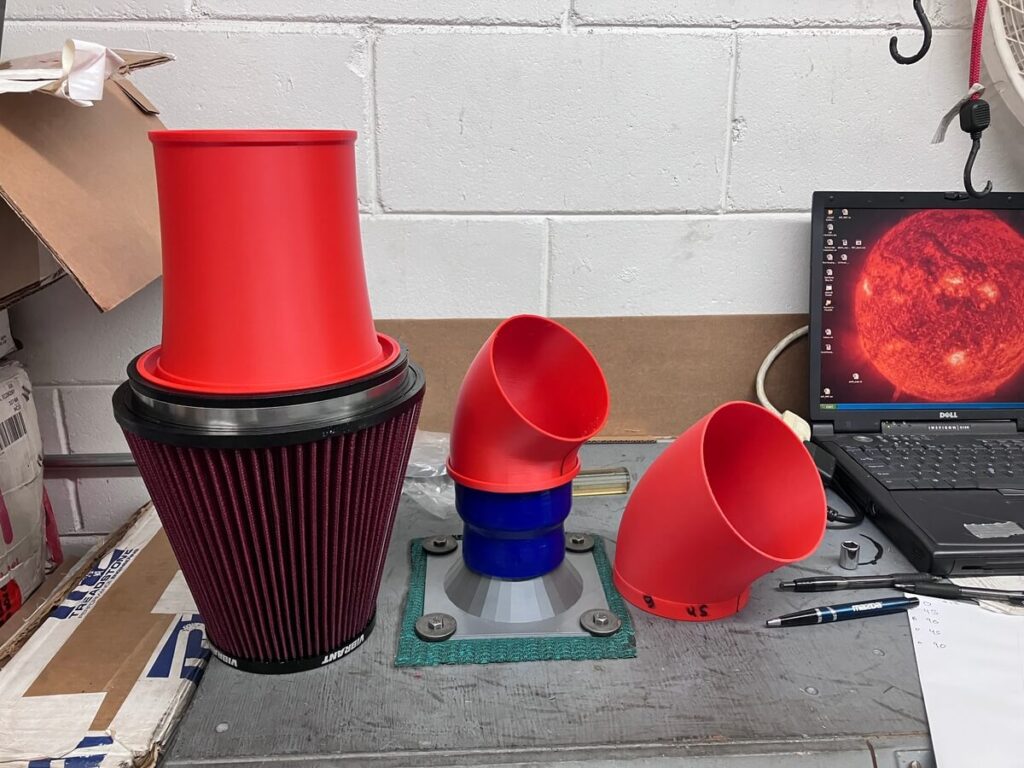
A variation of the flow testing will include rotating the inlet pipe just before entering the inlet elbow transition. This is being done to understand how design variations to facilitate fit within the engine compartment might affect airflow through the 3″ adapter configuration.
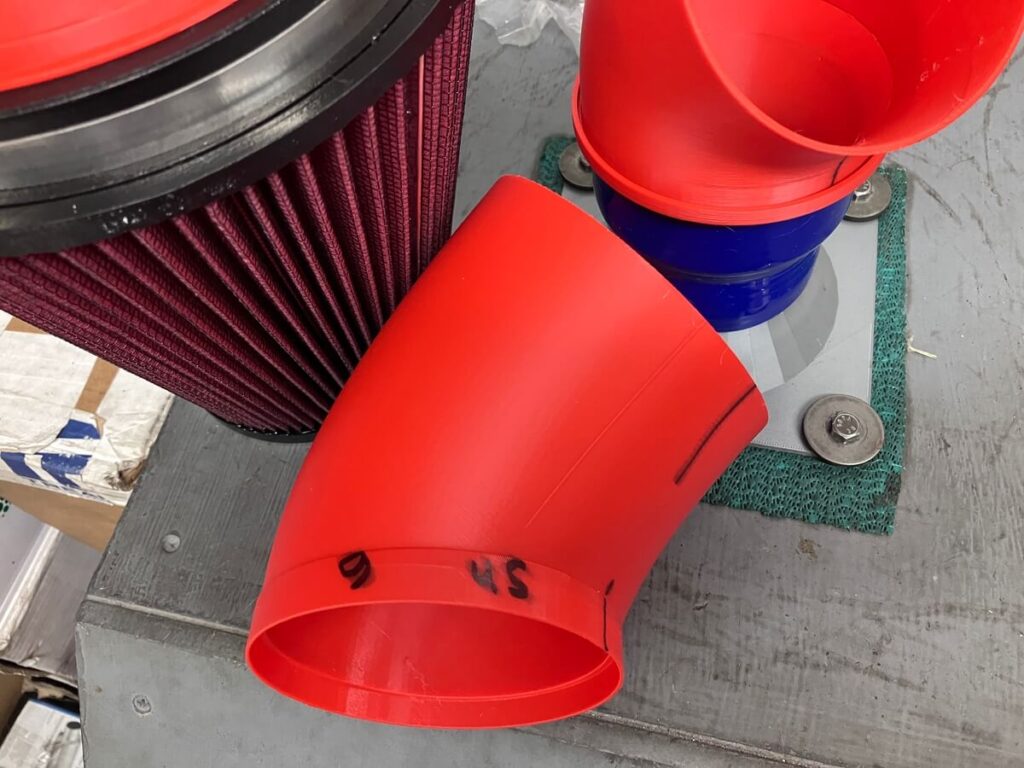
The Beta-6 intake is assembled and attached to the flow bench using a 3″ adapter.
Note: All setups in this test session are attached to the flow bench using the 3″ adapter. They are also tested at 13″ of H2O and 5″ of H2O. The lower test pressure is due to the Beta-6 flowing at the maximum the flow bench can support, approximately 600 CFM.
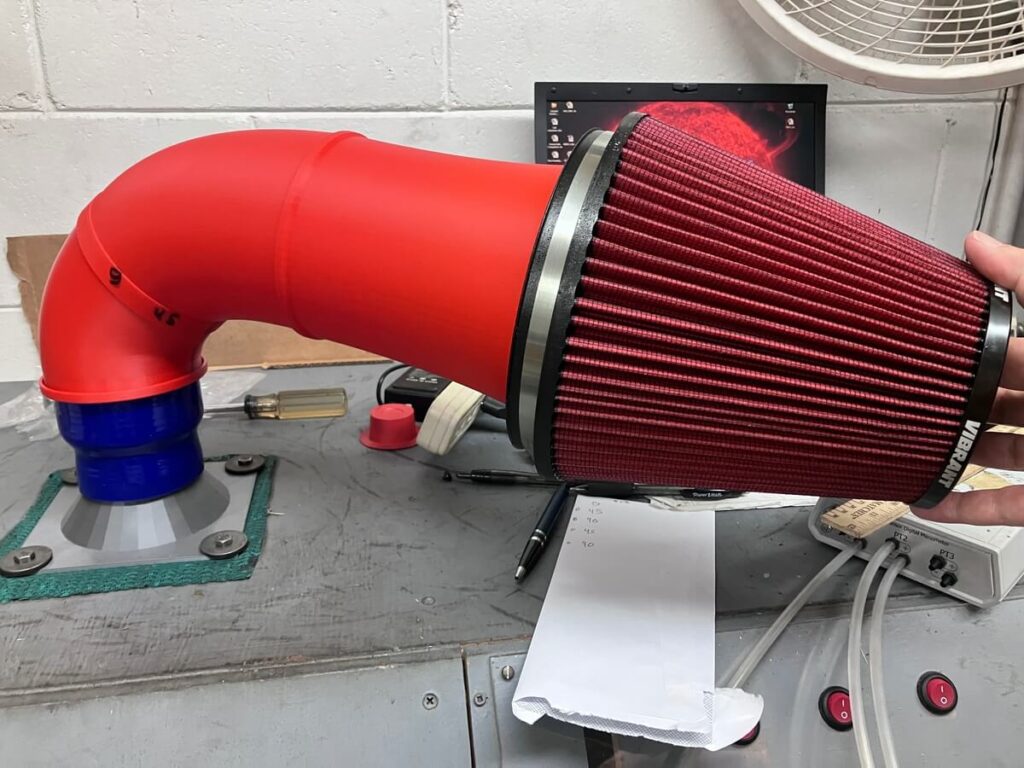
The AMS, Blaze ATOM, MGM7 Beta-2, and Beta-5 intakes are other setups tested for comparisons.
The AMS intake is being tested without the carbon fiber enclosure, which more closely replicates the Beta-6’s configuration.

The Blaze ATOM Race is tested in two configurations since it cannot be configured similarly to the Beta-6. The Beta-6 is designed for use with a standard Turbo Inlet Elbow, while the Blaze has part of the elbow shape incorporated into its inlet hose.
The Blaze ATOM is tested with the inlet hose attached, which should flow less than the other intakes since the Blaze inlet hose has an additional bend compared to the other tested parts.
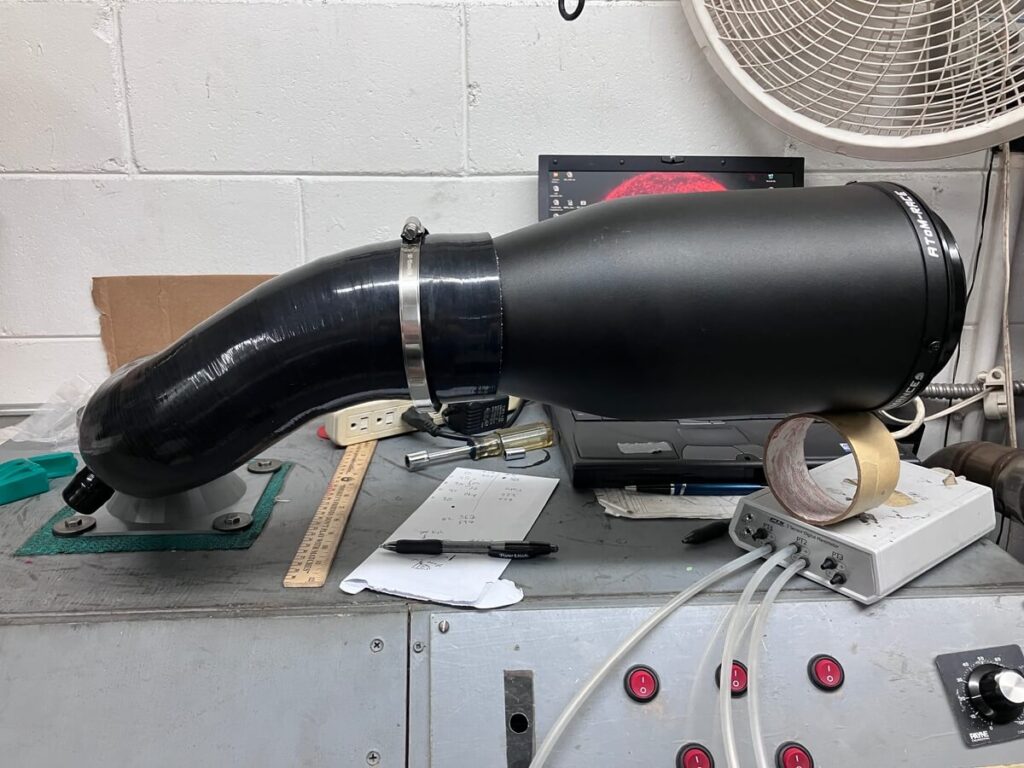
The second Blaze ATOM configuration does not have the inlet hose, so only the air filter housing is attached to the flow bench. In this configuration, the Blaze should flow more than the other intakes.
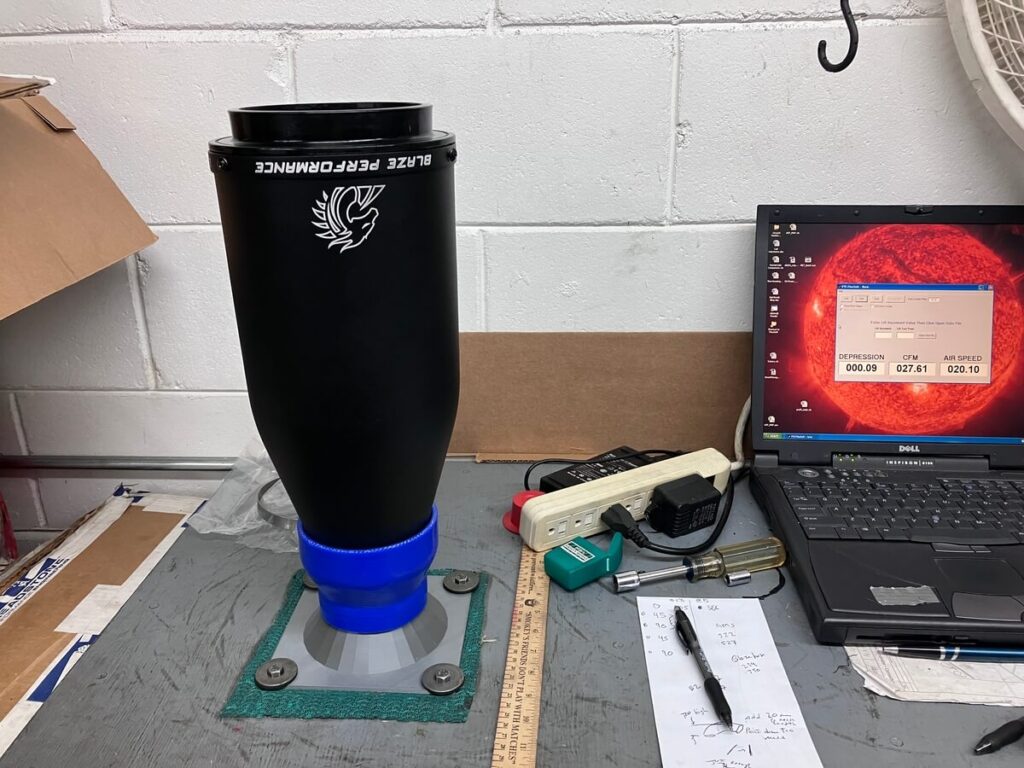
The next intake to be tested is the MGM7 Beta-2. This intake uses a smaller 6″ flange Vibrant air filter and a smaller diameter inlet pipe than the Beta-6.
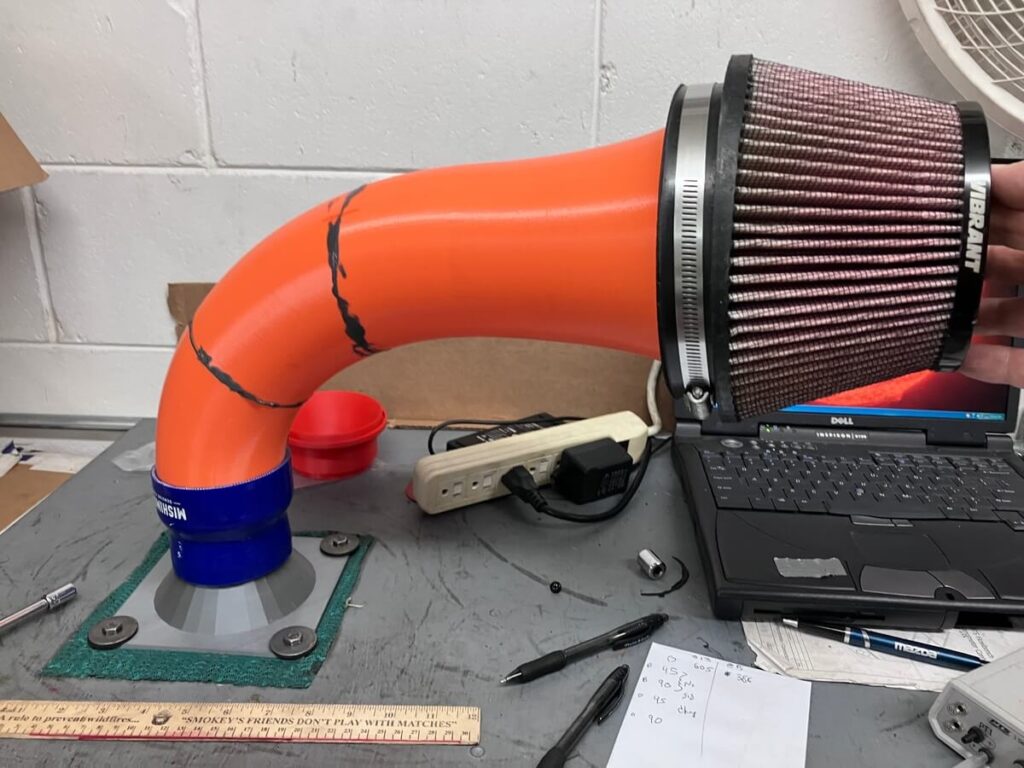
Beta-5 is being tested at 10″ and 5″ of H2O.
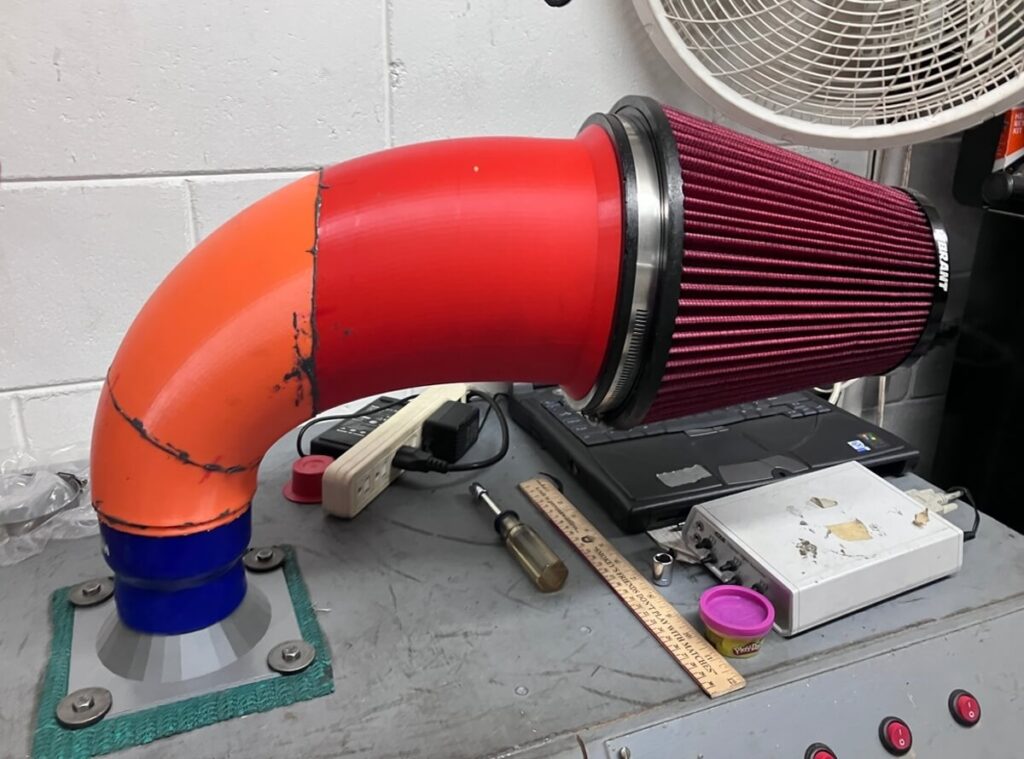
Test Results:
The Beta-6 intake flow rate is 605 CFM @ 13″ of H2O.
This rate is higher than the other intakes tested, but the difference with Beta-2 is smaller than expected. Beta-6 uses a slightly larger filter flange, 7″ versus 6″, and the inlet pipe portion is slightly larger than with Beta-2.
The two commercial intakes (AMS & Blaze Performance) flow a fair amount less than the Beta-6 intake.
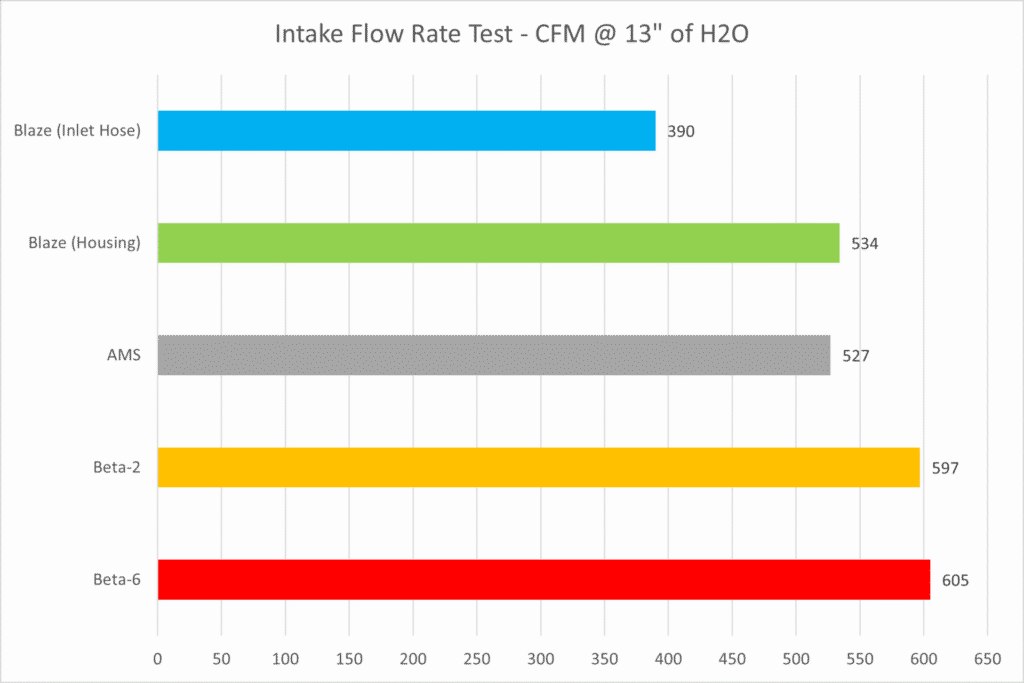
The test is repeated at a test depression of 5″ of H2O. The lower test pressure will allow me to evaluate whether the upper-end measures are accurate. As mentioned, the bench’s maximum flow rate is around 600 CFM. With the two beta intakes flowing near this limit, there may be more of a difference between the intakes than the comparison at the 13″ pressure indicates.
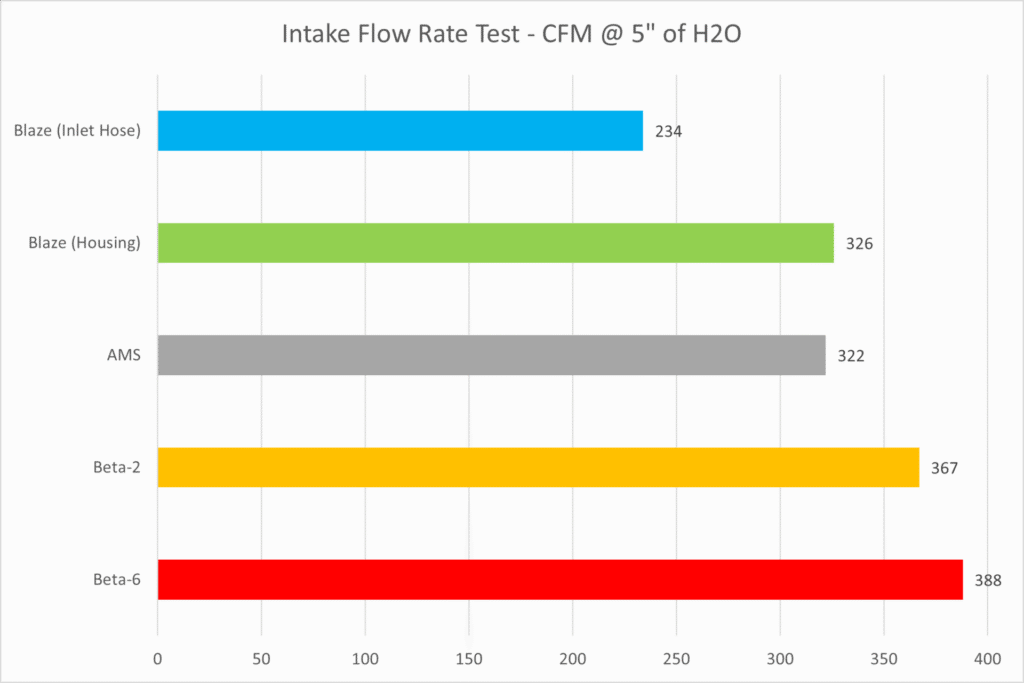
As suspected, the difference between the Beta-6 and Beta-2 intakes increases at the lower test pressure. At 13″ of H2O, Beta-6 flows 1.3% more than Beta-2, but at 5″ of H2O, the difference increases to 5.7%, supporting the hypothesis that the bench maximum flow rate is reached with these intakes.
Another commonly used test pressure is 10″ of H2O. At this pressure, the flow rates will be higher than 5″ but sufficiently far beneath the bench limits to not influence the readings.
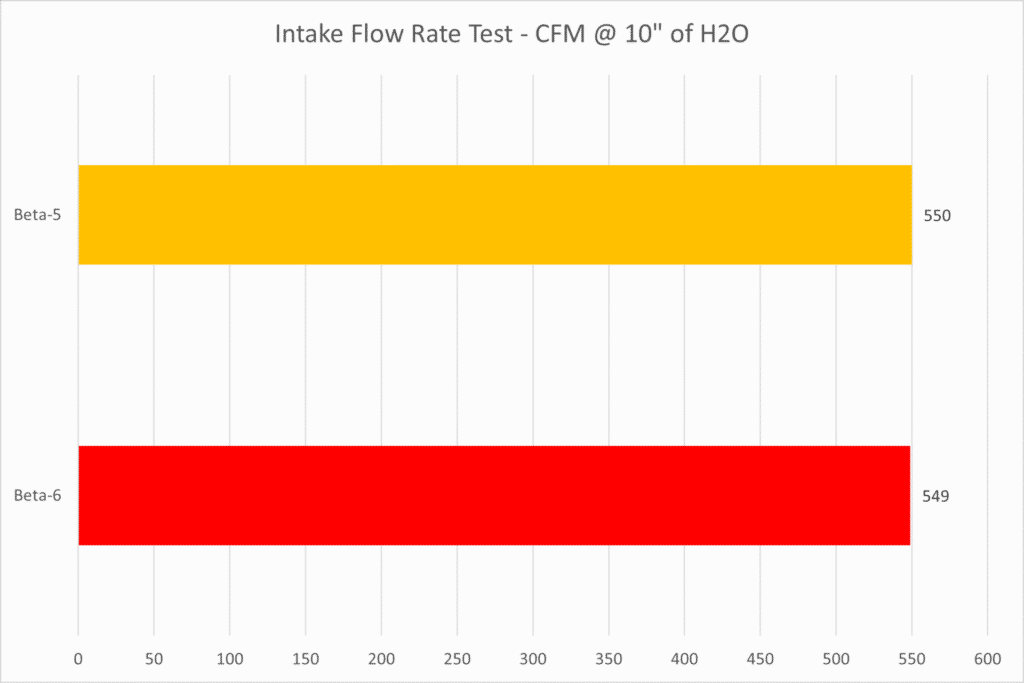
Beta-6 flows within the measurement margin of error of Beta-5, indicating that it flows very well. However, the 3″ adapter is likely the most significant factor contributing to the maximum flow rate through these intakes.
Rotation Test:
A test variation involved rotating the intake inlet relative to the elbow segment. Two positions, 45 degrees, and 90 degrees, were tested.
Neither rotated configuration produced a difference from the baseline measure.
The lack of a difference is likely due to the inlet pipe being 4.5″ to 5″ in diameter and having less contribution to the overall flow rate than the 3″ elbow segment.
Test Fitting:
Past designs emphasized performance to establish thresholds of what is possible. The Beta-6 design reflects a shift in emphasis to an intake intended to fit within the engine compartment.
The Beta-6 is assembled and installed in the Mk7 GTI engine compartment to check for fit.
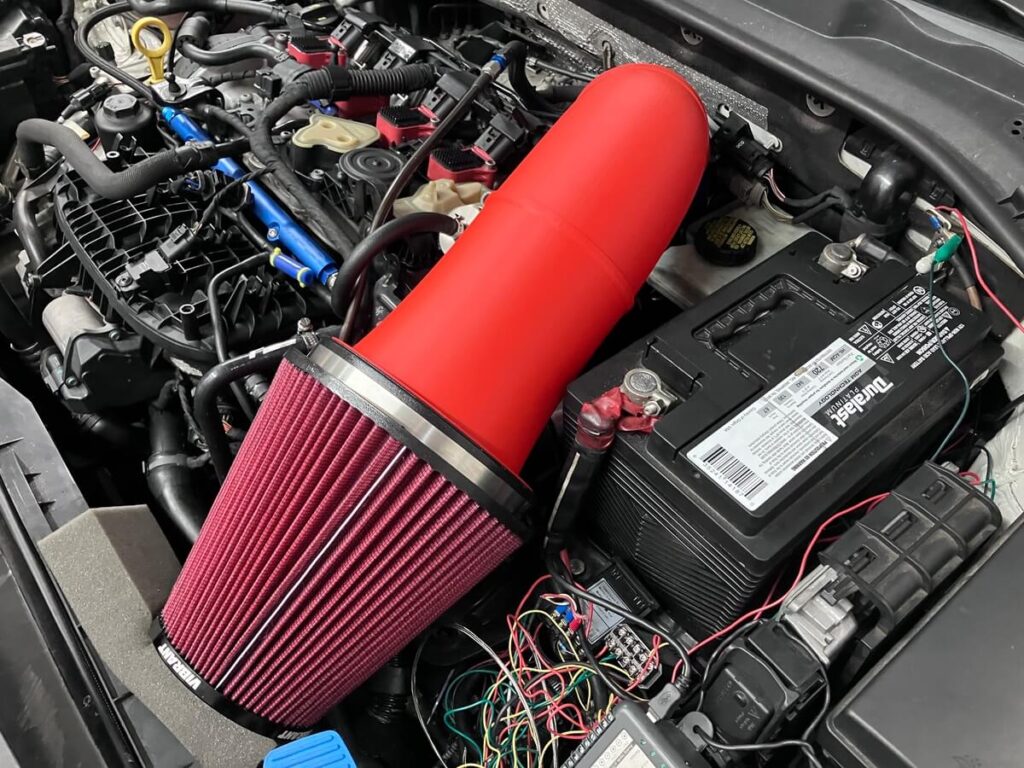
The Beta-6 is close to fitting but is a little too tall at the topmost point, just before the bend into the elbow starts.
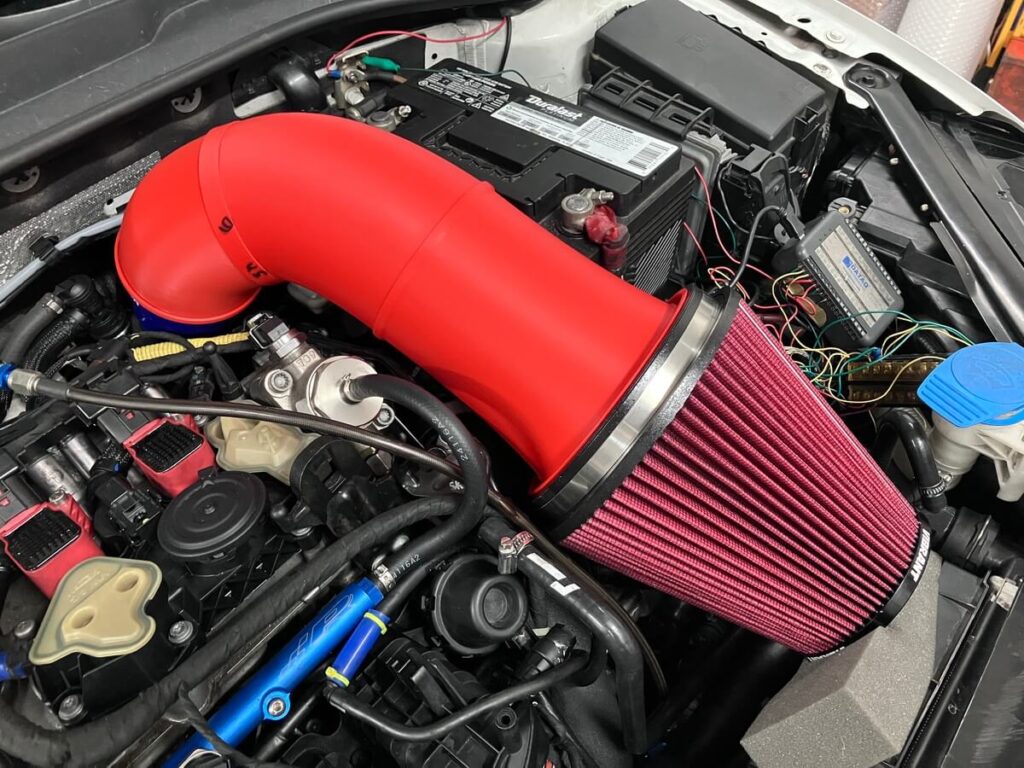
Fortunately, there is room beneath the Beta-6 inlet pipe to lower the pipe and clear the hood when it is closed.
Conclusions:
The MGM7 Beta-6 intake was tested and found to flow over 600 CFM @ 13″ of H2O. This flow rate is at the flow bench maximum, and comparing it with the Beta-2 at this flow rate is considered inaccurate.
The AMS Performance intake and Blaze ATOM air filter housing flow approximately 14% less than the Beta-6 intake.
When tested with a 3″ adapter at 10″ of H2O, the Beta-6 flows the same as the Beta-5, but the Beta-6 is close to fitting within the Mk7 GTI engine compartment, whereas the Beta-5 does not.
References:
Additional Reading:
This link is to an interesting article on the Grassroots Motorsports website where they talk about designing an automotive intake.

Be aware that if you subscribe to the Ed Susman Equilibrium Tuning unsubstantiated opinion that the PTS flow bench that I use (as do other people and businesses) for testing “doesn’t flow enough to test automotive flow parts“…


Which is to say, that the eight (8) vacuum motors are a “limiting factor” and don’t “allow for proper testing.”
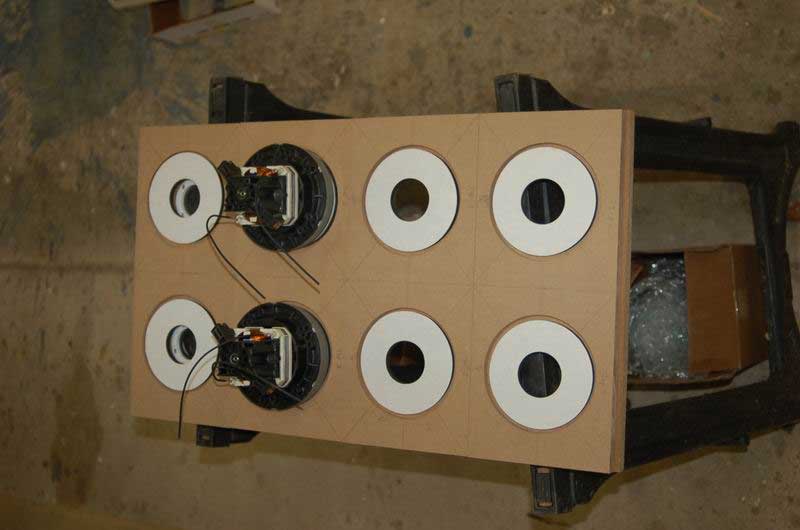
If so, you should not read the Grassroots Motorsports article, as they borrowed a single motor flow bench from the Hope College Formula SAE Team to conduct their testing.
If, as Ed Susman claims, eight motors aren’t enough, then one motor has no chance of producing proper results.

Ed ought to let these folks know the equipment they are testing with is inadequate and doesn’t allow for proper testing.
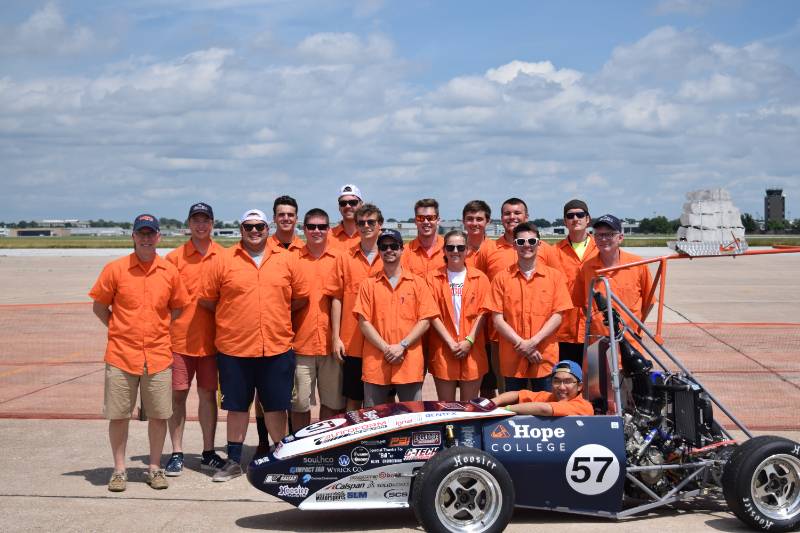
Or maybe Ed Susman should stop the dishonest bullshitting of unwary consumers on social media and stick to being a car parts salesman.


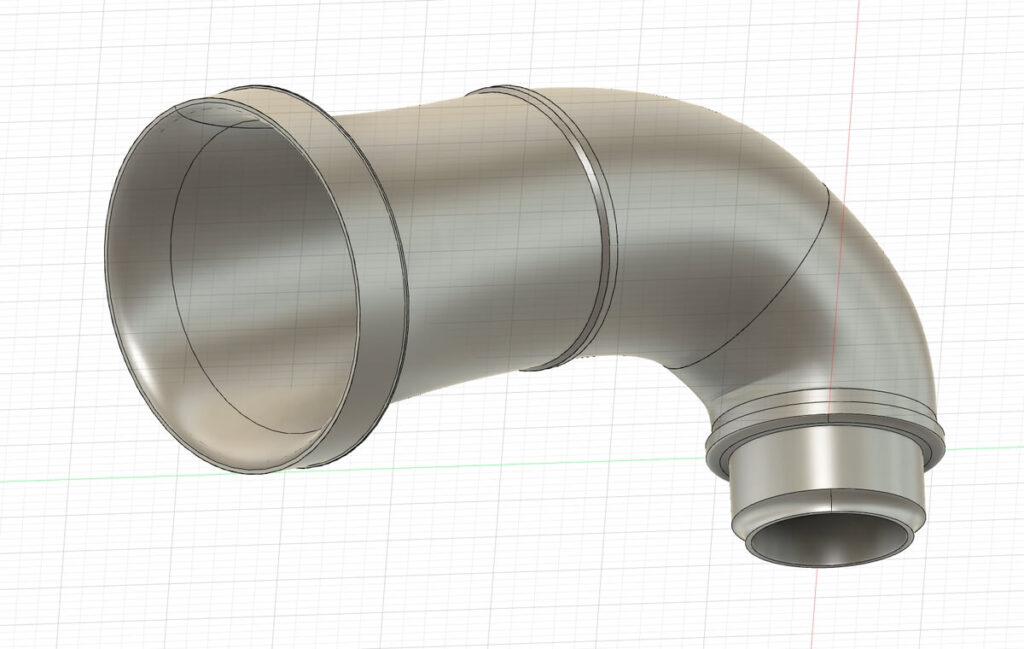
You are doing the very thing you purport to detest. When did anyone ever
question the fact that the flow bench has eight motors? “If, as Ed
Susman claims, eight motors aren’t enough, then one motor has no chance
of producing proper results.” Please show data when that was said, or
are you performing some embellishment of your own?
Hi Joe, I’ll address a couple of your points to clarify. The post does not intend to embellish Ed Susman’s claims (this is a strawman fallacy). The statement about a flow bench with eight motors being inadequate is an interpretation of Ed Susman’s claim that the bench I am using, which happens to have eight motors, is inadequate. Logically this implies that if it, with eight motors are insufficient, a single motor would be even less capable. This was not an embellishment but rather an assessment of the implications of Ed Susman’s claim.
As for your concern that the report is doing the very thing it criticizes (the false equivalence fallacy), I’ll point out that holding someone accountable by examining their claims is not the same as making unfounded or exaggerated assertions. This part of the post aims to highlight the issue of Ed Susman bullshitting consumers, by bringing attention to his unsubstantiated claims, that may impact consumer decisions.
So if I’m understanding correctly short of making a custom intake the currently available best option/combination are the CTS intake with the dbv2 inlet?
I don’t have enough information to say whether that is correct or not. There are a number of intakes I have never tested. I think with respect to airflow that combination is probably among the best available, and differences with other high-flowing intakes are likely to be inconsequential.
I’m glad that you’re honest about your testing and the results from the ones you have tested along with the fact you admitted to not have tested all the available ones. One other question, are you considering releasing the intake you are currently developing?
If/when I finish with the intake I would like to make it available for other people to use, but I don’t know how I would go about that, considering I have not been designing it with the intention of offering it to others.